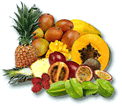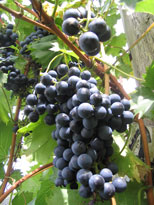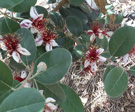
January 2007
The Daley News
The nursery orchard is offering us many treats at this time of the year, the variety on offer is fantastic and there is something fruiting to keep us all happy. Our bumper crop of plums are just finishing but there are a number of varieties we have in our orchard that have been cropping for the  last three months. Wax jambus are adorning our trees, they make a delicious and refreshing crunchy snack to start the day as well as looking beautiful on the trees. There has been a good crop of nashis despite the warmer winter, the Hosui has produced the best crop for us here in Kyogle this year. It is January and we are enjoying our second crop of mulberries from the dwarf black mulberry trees that were pruned back by 1/3 after they finished their first crop. They are very generous little trees. We have a awesome crop of grapes which have us all thinking of making organic wine and arguing over which is the tastiest of the table varieties, my
last three months. Wax jambus are adorning our trees, they make a delicious and refreshing crunchy snack to start the day as well as looking beautiful on the trees. There has been a good crop of nashis despite the warmer winter, the Hosui has produced the best crop for us here in Kyogle this year. It is January and we are enjoying our second crop of mulberries from the dwarf black mulberry trees that were pruned back by 1/3 after they finished their first crop. They are very generous little trees. We have a awesome crop of grapes which have us all thinking of making organic wine and arguing over which is the tastiest of the table varieties, my  pick is the Carolina Black Rose, it is large, crisp and sweet, the chambourcin is the pick of the wine grapes for coastal regions, as well as being tasty on the table it has great disease resistance. Lady Patricia is an excellent white table grape also with high disease resistance. Kerriberry are fruiting for those who love the trailing berries, they make a delicious pie. Luscious lychees are cropping now as are a couple of my other favourites the panama berry and native finger limes.
pick is the Carolina Black Rose, it is large, crisp and sweet, the chambourcin is the pick of the wine grapes for coastal regions, as well as being tasty on the table it has great disease resistance. Lady Patricia is an excellent white table grape also with high disease resistance. Kerriberry are fruiting for those who love the trailing berries, they make a delicious pie. Luscious lychees are cropping now as are a couple of my other favourites the panama berry and native finger limes.
Attracting Butterflies to your Garden
 Summer is a beautiful time in the great outdoors and it is a wonderful time to see all sorts of different butterflies. My favourite is the Richmond Birdwing Butterfly a large and spectacular species which can be seen on the wing at this time of the year. They are totally dependant on the Richmond birdwing butterfly vine - Pararistolochia praevenosa , the lowland species and in mountainous regions around the border Pararistolochia laheyana which are the only food sources for the caterpillars. Butterflies will mistakenly lay their eggs on the exotic and toxic Dutchman’s pipe vine – Aristolochia elegans with disastrous consequences as the caterpillars are poisoned and die as soon as they begin to feed.
Summer is a beautiful time in the great outdoors and it is a wonderful time to see all sorts of different butterflies. My favourite is the Richmond Birdwing Butterfly a large and spectacular species which can be seen on the wing at this time of the year. They are totally dependant on the Richmond birdwing butterfly vine - Pararistolochia praevenosa , the lowland species and in mountainous regions around the border Pararistolochia laheyana which are the only food sources for the caterpillars. Butterflies will mistakenly lay their eggs on the exotic and toxic Dutchman’s pipe vine – Aristolochia elegans with disastrous consequences as the caterpillars are poisoned and die as soon as they begin to feed. Cultivation of this vine should be strongly discouraged. Caterpillars have a ferocious appetite and need a large vine to support them; they can be cannibalistic if they encounter other caterpillars as this reduces competition for food. Birdwing butterflies feed on nectar rich flowers like native rosella, tallowwood and even lantana, they are territorial and males in particular prefer hilltop locations. Attracting butterflies to your garden is simple and fun. Plant the food source for the caterpillars of the species that you want to attract and provided the butterflies live in your area they will come to lay their eggs. It is also important to provide your butterflies with some nectar rich food plants so that they will feed from your garden while they are there, remember that cultivars tend to be showy but often have less nectar than native species which will attract and feed more birds and insects. Here are some excellent host plants to get you started. Native mulberry - Pipturus argenteus food for the Jezebel Nymph and the Yellow Admiral Macadamia – food for several small butterflies. Common Penciled-blue, Hairy Line-blue, Large Purple Line-blue, Purple Line-blue, Small-tailed Line-blue, Small-tailed Line-blue. The strangest of them is the Bright Cornelian, the caterpillar of this butterfly feeds on the kernel of the nut leaving a hole in the shell of the nut for waste disposal, it plugs this closed with its heavily armored bottom which bizarrely has a smiley face on it. Red Ash – Alphitonia excelsa – is food for the Small Green banded Blue and the Indigo Flash Leichhardt Bean - Cassia Brewsteria – is the host for the Lemon Migrant butterfly Native sandpaper fig - Ficus coronata and European edible figs support the Purple Moonbeam Native citrus, the finger lime and the round lime and other citrus are the food source for the caterpillars of several butterflies including the Orchard Swallowtail, Fuscous Swallowtail and the Dainty Swallowtail, they are common in home orchards that have citrus trees at this time of the year. Cinnamon trees attract the Blue Triangle which also feed on other laurel tree. Custard apples and Soursops attract the Pale Triangle. A couple of fantastic little books to help get you started are Butterfly Host Plants of South-east Queensland and Northern NSW by John T Moss Create More Butterflies by Frank Jordan and Helen Schwenke – It is true, since Greg introduced me to this wonderful book there seem to be more butterflies in the world. Both these titles and more are available from Earthling Enterprises – www.earthling.com.au Frank and Helen run butterfly tours each year at the Woodford Folk Festival.The winner of the best documentary at the Spirit of Woodford
Cultivation of this vine should be strongly discouraged. Caterpillars have a ferocious appetite and need a large vine to support them; they can be cannibalistic if they encounter other caterpillars as this reduces competition for food. Birdwing butterflies feed on nectar rich flowers like native rosella, tallowwood and even lantana, they are territorial and males in particular prefer hilltop locations. Attracting butterflies to your garden is simple and fun. Plant the food source for the caterpillars of the species that you want to attract and provided the butterflies live in your area they will come to lay their eggs. It is also important to provide your butterflies with some nectar rich food plants so that they will feed from your garden while they are there, remember that cultivars tend to be showy but often have less nectar than native species which will attract and feed more birds and insects. Here are some excellent host plants to get you started. Native mulberry - Pipturus argenteus food for the Jezebel Nymph and the Yellow Admiral Macadamia – food for several small butterflies. Common Penciled-blue, Hairy Line-blue, Large Purple Line-blue, Purple Line-blue, Small-tailed Line-blue, Small-tailed Line-blue. The strangest of them is the Bright Cornelian, the caterpillar of this butterfly feeds on the kernel of the nut leaving a hole in the shell of the nut for waste disposal, it plugs this closed with its heavily armored bottom which bizarrely has a smiley face on it. Red Ash – Alphitonia excelsa – is food for the Small Green banded Blue and the Indigo Flash Leichhardt Bean - Cassia Brewsteria – is the host for the Lemon Migrant butterfly Native sandpaper fig - Ficus coronata and European edible figs support the Purple Moonbeam Native citrus, the finger lime and the round lime and other citrus are the food source for the caterpillars of several butterflies including the Orchard Swallowtail, Fuscous Swallowtail and the Dainty Swallowtail, they are common in home orchards that have citrus trees at this time of the year. Cinnamon trees attract the Blue Triangle which also feed on other laurel tree. Custard apples and Soursops attract the Pale Triangle. A couple of fantastic little books to help get you started are Butterfly Host Plants of South-east Queensland and Northern NSW by John T Moss Create More Butterflies by Frank Jordan and Helen Schwenke – It is true, since Greg introduced me to this wonderful book there seem to be more butterflies in the world. Both these titles and more are available from Earthling Enterprises – www.earthling.com.au Frank and Helen run butterfly tours each year at the Woodford Folk Festival.The winner of the best documentary at the Spirit of Woodford  in 2006/2007 was Lachlan Forsyth with his beautiful short film called The Butterfly Kiss which you can watch a snippet by pressing play above. Since 1997 over 60,000 trees have been planted at the Woodford festival site with a small group of volunteers focusing their efforts on butterfly and invertebrate conservation. The film is an analogy for the life of the butterfly and our contact with the natural world as human beings. We have copies of this on DVD for anyone who is interested.
in 2006/2007 was Lachlan Forsyth with his beautiful short film called The Butterfly Kiss which you can watch a snippet by pressing play above. Since 1997 over 60,000 trees have been planted at the Woodford festival site with a small group of volunteers focusing their efforts on butterfly and invertebrate conservation. The film is an analogy for the life of the butterfly and our contact with the natural world as human beings. We have copies of this on DVD for anyone who is interested.
The next time your garden is being munched and your trees are being stripped bare think of the colour and life of butterflies; they are like flying flowers in your garden not to mention the amazing changes in their lives as they transform themselves from grubs into flying jewels.
Feijoa - Feijoa sellowiana
Feijoas are beautiful ornamental fruit trees that produce both delicious fruits and stunning edible flowers. They are easy to grow although they  like cool winters and long warm summers, they are not fussy about soil types but the best harvest will come from a deep well drained fertile soil. The feijoa is native to southern Brazil, northern Argentina, western Paraguay and Uraguay where it commonly seen in the mountainous araucaria forests. A versatile spreading tree, feijoas should be planting about 4.5-5.5 meters apart for good fruit production, however it does make an attractive hedge where it can be planted 1-1.5 meters apart to form an attractive barrier hedge, a mix of different cultivars will ensure cross pollination and a bumper crop. An evergreen, the good looking foliage is a soft olive green above and silvery below. Flowers are eye catching and produce a spectacular display in spring, the fleshy petals are edible, birds eating them may help pollination but the main
like cool winters and long warm summers, they are not fussy about soil types but the best harvest will come from a deep well drained fertile soil. The feijoa is native to southern Brazil, northern Argentina, western Paraguay and Uraguay where it commonly seen in the mountainous araucaria forests. A versatile spreading tree, feijoas should be planting about 4.5-5.5 meters apart for good fruit production, however it does make an attractive hedge where it can be planted 1-1.5 meters apart to form an attractive barrier hedge, a mix of different cultivars will ensure cross pollination and a bumper crop. An evergreen, the good looking foliage is a soft olive green above and silvery below. Flowers are eye catching and produce a spectacular display in spring, the fleshy petals are edible, birds eating them may help pollination but the main  pollinator is bees. The fruits fall when mature and should be collected daily from below the tree. A thick layer of straw mulch will protected the falling fruits from bruising. Fruits picked from the tree will not have the full richness of flavour. In the kitchen feijoas are used in desserts, salads, preserves and pastries, they can also me made into sauces, chutneys or wine. In fruit fly prone areas it is important to protect your crop with a fruit fly control program, we use the organic product Eco Naturalure which is an effective control of the Queensland fruit fly.
pollinator is bees. The fruits fall when mature and should be collected daily from below the tree. A thick layer of straw mulch will protected the falling fruits from bruising. Fruits picked from the tree will not have the full richness of flavour. In the kitchen feijoas are used in desserts, salads, preserves and pastries, they can also me made into sauces, chutneys or wine. In fruit fly prone areas it is important to protect your crop with a fruit fly control program, we use the organic product Eco Naturalure which is an effective control of the Queensland fruit fly.
Lemon Scented Ironbark - Eucalyptus staigeriana
 Eucalypts are a large and interesting group of trees and this is another of our wonderful native bush food species. The lemon scented ironbark is a small rough barked tree native to the Palmer River region of Cape York in far north Queensland where it grows in pure stands on the hillsides. Trees grow well in the fertile soils of northern NSW. The leaves have a fresh, clean lemon scent, the oil produced from the leaves is used in aromatherapy where it is an excellent choice for people with sensative skins who may react to citrus oils. The leaves are also used as a flavouring in the bush food industry where they can be ground into a powder and used as a spice or used whole like a bay leaf. They have a fruity lemon taste with a slight eucalypt undertone giving it that true bush food flavour.
Eucalypts are a large and interesting group of trees and this is another of our wonderful native bush food species. The lemon scented ironbark is a small rough barked tree native to the Palmer River region of Cape York in far north Queensland where it grows in pure stands on the hillsides. Trees grow well in the fertile soils of northern NSW. The leaves have a fresh, clean lemon scent, the oil produced from the leaves is used in aromatherapy where it is an excellent choice for people with sensative skins who may react to citrus oils. The leaves are also used as a flavouring in the bush food industry where they can be ground into a powder and used as a spice or used whole like a bay leaf. They have a fruity lemon taste with a slight eucalypt undertone giving it that true bush food flavour.
Wax jambu Jelly
Thank you to Rosemary Neal for sending me this recipe, it works for any of the lily pillies and is a great way to preserve your wax jambu crop.
This recipe has been in the Amy Schauer book forever and works well ..
Wash fruit; place in saucepan and just cover with water. Bring to boil and simmer 1 hours. Squash down fruit to release juice and strain through muslin.Measure juice; allow 1 cup sugar & 1 dessertspoon lemon per cup of juice.Bring juices to simmering, add warmed sugar. Boil hard for 10 mins. Check if it jells and then place into sterilised jars. YU





